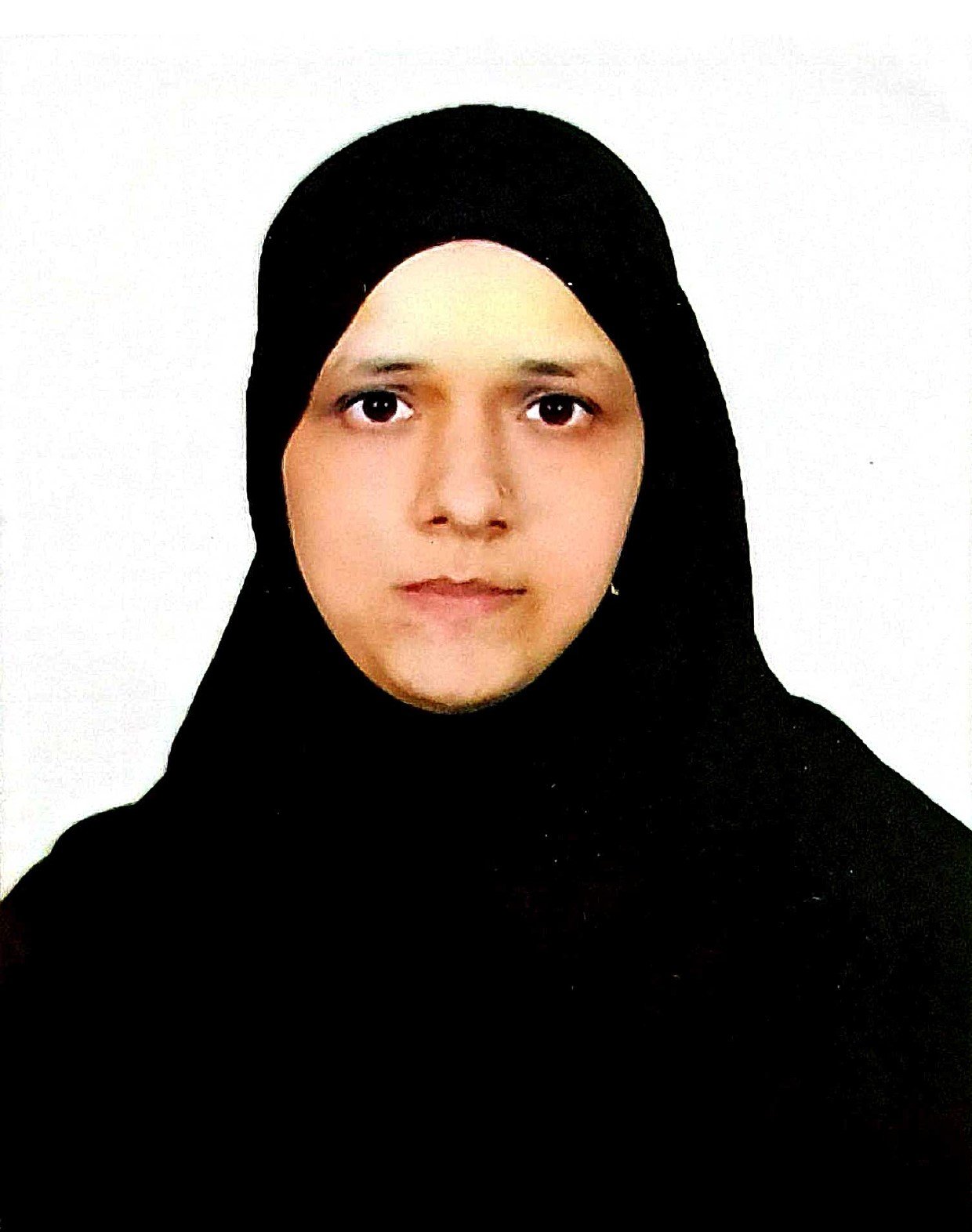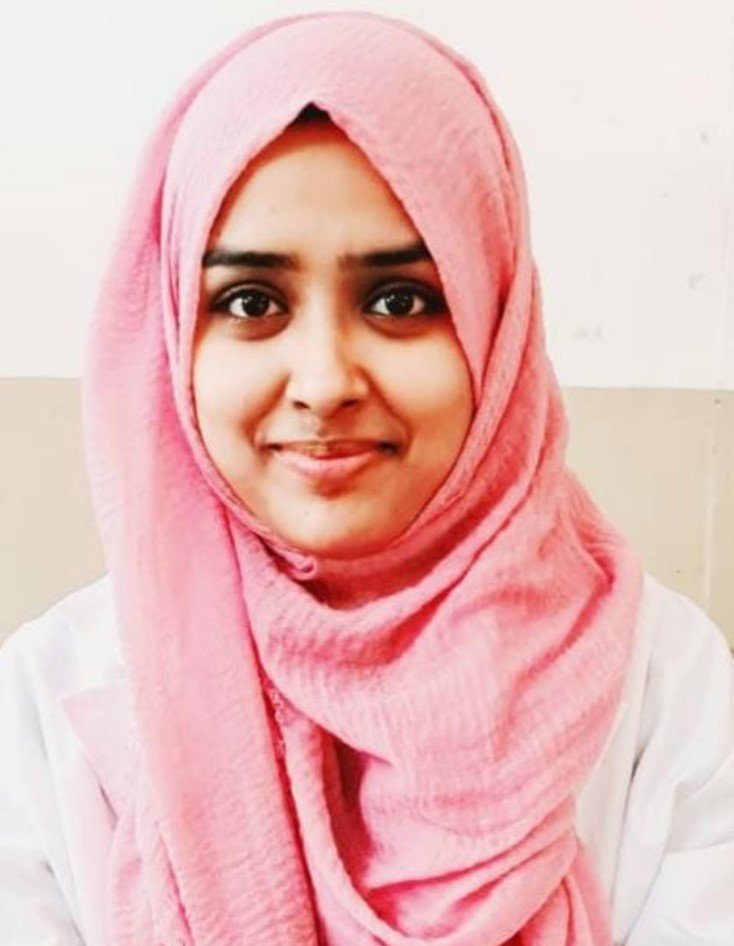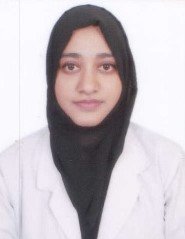
Microbiology
- Home
- Microbiology
Medical microbiology, the large subset of microbiology that is applied to medicine, is a branch of medical science concerned with the prevention, diagnosis and treatment of infectious diseases. In addition, this field of science studies various clinical applications of microbes for the improvement of health. There are four kinds of microorganisms that cause infectious disease: bacteria, fungi, parasites and viruses, and one type of infectious protein called prion.
Faculty
| Teaching Staff | |||
| Photo | Name of the Faculty Qualification Registration No. |
Designation | Details |
|---|---|---|---|
 |
Dr. Sarwat Fatima M.B.B.S., M.D - Microbiology Reg No: 37695 |
Professor & HOD | View Details |
 |
Dr. Maimoona Mustafa M.B.B.S., M.D - Microbiology Reg No: HMC11994 |
Professor | View Details |
 |
Dr. Grishma Vijaykumar kulkarni M.B.B.S., M.D - Microbiology Reg No: 68621 |
Associate Professor | View Details |
 |
Dr. Shaheen Sultana M.B.B.S., M.D - Microbiology Reg No: 65840 |
Assistant Professor | View Details |
 |
Dr. Shaheen Siddiqua Amrin M.B.B.S., M.D - Microbiology Reg No: 73784 |
Assistant Professor | View Details |
 |
Dr. Qudsiya Begum Alias Farheen M.B.B.S., M.D - Microbiology Reg No: TSMC/FMR/04055 |
Assistant Professor | View Details |
 |
Dr. Syed Sarhan Uddin M.B.B.S., M.D - Microbiology Reg No: TSMC/FMR/04396 |
Assistant Professor | View Details |
 |
Dr. Hajera Masroor M.B.B.S., M.D - Microbiology Reg No: 54091 |
Assistant Professor | View Details |
 |
Dr. Shahbaz Sajjad M.D.(Physician) Equivalent to M.B.B.S. Reg No: APMC/FMR/94597 |
Tutor | View Details |
 |
Dr. Taiyaba Fatima M.B.B.S. Reg No: APMC/FMR/89550 |
Tutor | View Details |
 |
Dr. Simra Naaz M.B.B.S. Reg No: TSMC/FMR/30330 |
Tutor | View Details |
 |
Dr. M. A. Wahab Ansari M.B.B.S. Reg No: HMC13399 |
Tutor | View Details |
 |
Dr. Naureen Zaidi M.B.B.S. Reg No: APMC/FMR/94338 |
Tutor | View Details |
 |
Dr. Farhan Shaik M.B.B.S. Reg No: 62388 |
Tutor | View Details |
| Non-Teaching Staff | ||
| Name | Designation | |
|---|---|---|
Achievments & Recognitions
Publications
2024
Fatima, Sarwat; Hazari, Ahmed Abdul Bari; Handa, Deepika
In: IP International Journal of Medical Microbiology and Tropical Diseases, vol. 10, iss. 4, pp. 329-336, 2024, ISSN: 2581-4753 .
@article{Fatima_2024b,
title = {Seroprevalence of SARS-CoV-2 IgG antibodies in health care workers and the associated risk factors during the covid-19 pandemic period at a tertiary care heatlh center in South India},
author = {Sarwat Fatima and Ahmed Abdul Bari Hazari and Deepika Handa},
url = {https://pdf.ipinnovative.com/pdf/23488},
doi = {10.18231/j.ijmmtd.2024.056 },
issn = {2581-4753 },
year = {2024},
date = {2024-12-12},
urldate = {2024-12-12},
journal = {IP International Journal of Medical Microbiology and Tropical Diseases},
volume = {10},
issue = {4},
pages = {329-336},
abstract = {Background: Most of the published studies across the globe so far have demonstrated a highly variable seroprevalence rate of SARS-CoV-2 IgG antibodies in health care workers [HCW’s] during the pandemic period. Multiple risk factors were studied that influenced the seropositivity.
Aim & Objective: The primary aim of the study was to determine the seroprevalence of SARS-CoV-2 IgG in HCW’s in local settings during the pandemic period. The secondary objective was to categorize the HCW’s based on the history of symptoms of covid-19 and also to evaluate the relation between the various risk factors and seropositivity amongst the HCW’s.
Materials and Methods: A cross sectional prospective study was conducted on health care workers at a tertiary care hospital in Telangana state during the pandemic period between March to April 2021. Following enrollment and verbal consent from the participants descriptive data was collected using a validated questionnaire. SARS-CoV-2 IgG antibodies estimation was done using ELFA technology after obtaining IERB clearance.
Results: Of the 230 enrolled participants 141 [61.30%] fulfilled the inclusion criteria. The overall SARS-CoV-2 IgG seropositivity in the present study was 48 [34.04%]. Of the 72 [51.06%] symptomatic HCW’s, 19 [26.38%] were seropositive and of the 69 [48.93%] asymptomatic, 29 [42.02%] were seropositive. Among the various risk factors studied none were found to be significantly associated with seropositivity.
Conclusion: in the present study a greater number of asymptomatic HCW’s were found seropositive which could be due to several of the reasons discussed below one being silent transmission of the virus and demands further enquiry into the cause by improved research methodology.},
keywords = {},
pubstate = {published},
tppubtype = {article}
}
Aim & Objective: The primary aim of the study was to determine the seroprevalence of SARS-CoV-2 IgG in HCW’s in local settings during the pandemic period. The secondary objective was to categorize the HCW’s based on the history of symptoms of covid-19 and also to evaluate the relation between the various risk factors and seropositivity amongst the HCW’s.
Materials and Methods: A cross sectional prospective study was conducted on health care workers at a tertiary care hospital in Telangana state during the pandemic period between March to April 2021. Following enrollment and verbal consent from the participants descriptive data was collected using a validated questionnaire. SARS-CoV-2 IgG antibodies estimation was done using ELFA technology after obtaining IERB clearance.
Results: Of the 230 enrolled participants 141 [61.30%] fulfilled the inclusion criteria. The overall SARS-CoV-2 IgG seropositivity in the present study was 48 [34.04%]. Of the 72 [51.06%] symptomatic HCW’s, 19 [26.38%] were seropositive and of the 69 [48.93%] asymptomatic, 29 [42.02%] were seropositive. Among the various risk factors studied none were found to be significantly associated with seropositivity.
Conclusion: in the present study a greater number of asymptomatic HCW’s were found seropositive which could be due to several of the reasons discussed below one being silent transmission of the virus and demands further enquiry into the cause by improved research methodology.
Kulkarni, Grishma Vijaykumar
Cefoxitin and oxacillin resistance conundrums Journal Article
In: South Asian Journal of Research in Microbiology, vol. 18, iss. 11, pp. 1-11, 2024, ISSN: 2582-1989.
@article{nokey,
title = {Cefoxitin and oxacillin resistance conundrums},
author = {Grishma Vijaykumar Kulkarni},
url = {https://journalsajrm.com/index.php/SAJRM/article/view/395},
doi = {10.9734/sajrm/2024/v18i11395},
issn = {2582-1989},
year = {2024},
date = {2024-10-29},
journal = {South Asian Journal of Research in Microbiology},
volume = {18},
issue = {11},
pages = {1-11},
abstract = {Recently, mecA negative Staphylococcus aureus strains with decreased susceptibility to oxacillin and cefoxitin have been sporadically reported worldwide. They are called as borderline oxacillin resistant Staphylococcus aureus (BORSA). Almost, more than 30% of such strains are often misinterpreted and reported as MRSA (methicillin resistant Staphylococcus aureus ) due to the hyperproduction of beta lactamase enzyme and other reasons which results in invitro reduced
susceptibility to oxacillin as well as cefoxitin. Similar phenomenon is quite common in other staphylococci micrococci and macrococci. In order to identify beta lactamase hyperproducing staphylococci and other gram positive cocci and to avoid fals e reporting as methicillin resistant, a one year prospective study was conducted in Deccan college of medical sciences, Hyderabad, Telangana state, India in 2023. During one year duration, 5630 inpatient (IP) and 823 outpatient
(OPD) samples accounting for total 6453 cultures were received in the microbiology laboratory. Out of this,100 cultures of different samples showing pure growth of gram positive cocci suggestive of staphylococci, micrococci and other Gram positive cocci were included in the present study and tested against different antibiotics panel as per CLSI guidelines (Clinical and Laboratory Standards Institute.) Inclusion of amoxiclav disc to the antibiotics test panel as per recommendation by the special phenotypic methods for the detection of antibacterial resistance in the manual of clinical
microbiology was helpful to detect the beta lactamase hyperproducers (BHP) and helped to report correct identification of the organisms and curtailed the mismanagement of more than 95% of the patients. T herefore, I do recommend to differentiate borderline from true methicillin resistant strains to streamline the antibiotic therapy and hence further avoidance of selection of the resistant strains.},
keywords = {},
pubstate = {published},
tppubtype = {article}
}
susceptibility to oxacillin as well as cefoxitin. Similar phenomenon is quite common in other staphylococci micrococci and macrococci. In order to identify beta lactamase hyperproducing staphylococci and other gram positive cocci and to avoid fals e reporting as methicillin resistant, a one year prospective study was conducted in Deccan college of medical sciences, Hyderabad, Telangana state, India in 2023. During one year duration, 5630 inpatient (IP) and 823 outpatient
(OPD) samples accounting for total 6453 cultures were received in the microbiology laboratory. Out of this,100 cultures of different samples showing pure growth of gram positive cocci suggestive of staphylococci, micrococci and other Gram positive cocci were included in the present study and tested against different antibiotics panel as per CLSI guidelines (Clinical and Laboratory Standards Institute.) Inclusion of amoxiclav disc to the antibiotics test panel as per recommendation by the special phenotypic methods for the detection of antibacterial resistance in the manual of clinical
microbiology was helpful to detect the beta lactamase hyperproducers (BHP) and helped to report correct identification of the organisms and curtailed the mismanagement of more than 95% of the patients. T herefore, I do recommend to differentiate borderline from true methicillin resistant strains to streamline the antibiotic therapy and hence further avoidance of selection of the resistant strains.
Fatima, Sarwat; Ahmed, Mohammed Sarosh; Krishna, Madhipati Sai; Mustafa, Maimoona; Sajjad, Shahbaz
To explore the effectiveness of problem-based learning over conventional didactic lecture in microbiology for phase 2 MBBS students Journal Article
In: IOSR Journal of Research & Method in Education, vol. 14, iss. 1 (Series 2), pp. 26-30, 2024, ISSN: 2320–737X.
@article{Fatima_2024,
title = {To explore the effectiveness of problem-based learning over conventional didactic lecture in microbiology for phase 2 MBBS students},
author = {Sarwat Fatima and Mohammed Sarosh Ahmed and Madhipati Sai Krishna and Maimoona Mustafa and Shahbaz Sajjad},
url = {https://www.iosrjournals.org/iosr-jrme/papers/Vol-14%20Issue-1/Ser-2/D1401022630.pdf},
doi = {10.9790/7388-1401022630},
issn = {2320–737X},
year = {2024},
date = {2024-02-20},
urldate = {2024-02-20},
journal = {IOSR Journal of Research & Method in Education},
volume = {14},
issue = {1 (Series 2)},
pages = {26-30},
abstract = {Background:Problem based learning [PBL] has been identified and approved by many medical educationists
as one of the best teaching learning methods due to the fact that it improves students’ learning in all 3 domains and improves higher order thinking. Research has found its positive effect to be variable in different geographic settings. Aim & objectives: To explore the effectiveness of PBL over conventional lecture. To evaluate students’ performance using PBL rubrics. To determine student’s acceptance and perceptions of PBL.
Material& methods: the present study is a prospective experimental and interventional type. The IERB approval was obtained and project was pilot tested. Study participants were enrolled by verbal consent and sampled using quota and randomisation method. The sequential steps of the study include: orientation on PBL method, pre-test, a questionnaire on preparedness for self-directed learning [SDL], conduct of sessions by 2 different TL methods with exchange of groups, post-test, students grading and lastly general feedback. Statistical methods: Mean ± SD, unpaired t test and 5-point Likert scale was used for analysis of results. Results: Around 114 /147 [77.55%] enrolled and continued till the end. The overall mean scores for DL & PBL method of teaching were as 1.65 ± 0.53 & 1.70 ± 0.62 in pre-test and 6.84 ± 1.22 and 7.36 ± 1.07 in post-test with p values as 0.178 & 0.118. For individual topics in post-test the PBL group secured higher scores than DL except for one. The assessment and feedback on PBL gave variable results. Discussion &Conclusion: the present study couldn’t find any statistically significant difference in the learning outcomes while using 2 different TL methods. However, the questionnaire on SDL preparedness, assessment and feedback data revealed certain grey zones which demand further enquiry into students learning plans & preferences which could be one of the reasons for the outcome observed and open doors for future qualitative research. Limitations: students and faculty related factors besides study design might have influenced the outcomes observed. },
keywords = {},
pubstate = {published},
tppubtype = {article}
}
as one of the best teaching learning methods due to the fact that it improves students’ learning in all 3 domains and improves higher order thinking. Research has found its positive effect to be variable in different geographic settings. Aim & objectives: To explore the effectiveness of PBL over conventional lecture. To evaluate students’ performance using PBL rubrics. To determine student’s acceptance and perceptions of PBL.
Material& methods: the present study is a prospective experimental and interventional type. The IERB approval was obtained and project was pilot tested. Study participants were enrolled by verbal consent and sampled using quota and randomisation method. The sequential steps of the study include: orientation on PBL method, pre-test, a questionnaire on preparedness for self-directed learning [SDL], conduct of sessions by 2 different TL methods with exchange of groups, post-test, students grading and lastly general feedback. Statistical methods: Mean ± SD, unpaired t test and 5-point Likert scale was used for analysis of results. Results: Around 114 /147 [77.55%] enrolled and continued till the end. The overall mean scores for DL & PBL method of teaching were as 1.65 ± 0.53 & 1.70 ± 0.62 in pre-test and 6.84 ± 1.22 and 7.36 ± 1.07 in post-test with p values as 0.178 & 0.118. For individual topics in post-test the PBL group secured higher scores than DL except for one. The assessment and feedback on PBL gave variable results. Discussion &Conclusion: the present study couldn’t find any statistically significant difference in the learning outcomes while using 2 different TL methods. However, the questionnaire on SDL preparedness, assessment and feedback data revealed certain grey zones which demand further enquiry into students learning plans & preferences which could be one of the reasons for the outcome observed and open doors for future qualitative research. Limitations: students and faculty related factors besides study design might have influenced the outcomes observed.
2023
Sultan, Juhi Fatima; Razvi, Fatima; Haneef, Nayeem Sadath; Fatima, Sarwat
Sporotrichoid primary cutaneous nocardiosis: a rare case of isolated upper-limb involvement in a housewife Journal Article
In: Indian Dermatology Online Journal, vol. 15, iss. 2, no. pmid38550836, pp. 270-273, 2023, ISBN: 2229-5178.
@article{Sultan_2024,
title = {Sporotrichoid primary cutaneous nocardiosis: a rare case of isolated upper-limb involvement in a housewife},
author = {Juhi Fatima Sultan and Fatima Razvi and Nayeem Sadath Haneef and Sarwat Fatima},
url = {https://www.ncbi.nlm.nih.gov/pmc/articles/PMC10969236/pdf/IDOJ-15-270.pdf},
doi = {10.4103/idoj.idoj_133_23},
isbn = {2229-5178},
year = {2023},
date = {2023-10-05},
urldate = {2023-10-05},
journal = {Indian Dermatology Online Journal},
volume = {15},
number = {pmid38550836},
issue = {2},
pages = {270-273},
abstract = {Nocardiosis is a rare infection due to a ubiquitous, gram-positive, weakly acid-fast, filamentous, aerobic bacteria, that are usually responsible for opportunistic infection in immunocompromised patients. Less frequently, nocardiosis can affect immunocompetent patients, causing primary cutaneous infections. Here we present a case of a 45-year-old housewife with a 12-day history of red painful nodules arranged linearly on her right upper limb, without any apparent history of injuries or comorbidities, albeit with a hobby of gardening. The unusual yet characteristic presentation, microbiological findings, and excellent response to co-trimoxazole therapy were consistent with a diagnosis of sporotrichoid primary cutaneous nocardiosis. The uncommon lymphocutaneous presentation is often misdiagnosed. Therefore, keeping a high index of suspicion in such cases is important to improve the cure rate and prevent complications. },
keywords = {},
pubstate = {published},
tppubtype = {article}
}
2022
Fathima, Nusrath; Sultana, Qursheed; Anees, Syyeda; Ullah, Kaleem; Ryu, Vitaly; Khan, Aleem Ahmed; Ishaq, Mohammed
Autoimmune thyroid patients with CTLA-4 (+49A/G) GG/AG genotypes have high seropositivity to thyroid peroxidase than thyroglobulin Journal Article
In: Meta Gene, vol. 31, iss. suppl C, pp. 101010, 2022, ISSN: 2773-0441.
@article{Fathima_2022,
title = {Autoimmune thyroid patients with CTLA-4 (+49A/G) GG/AG genotypes have high seropositivity to thyroid peroxidase than thyroglobulin},
author = {Nusrath Fathima and Qursheed Sultana and Syyeda Anees and Kaleem Ullah and Vitaly Ryu and Aleem Ahmed Khan and Mohammed Ishaq},
url = {https://www.sciencedirect.com/science/article/abs/pii/S2214540022000019?via%3Dihub},
doi = {10.1016/j.mgene.2022.101010},
issn = {2773-0441},
year = {2022},
date = {2022-02-01},
urldate = {2022-02-01},
journal = {Meta Gene},
volume = {31},
issue = {suppl C},
pages = {101010},
publisher = {Elsevier BV},
abstract = {Despite increasing burden of autoimmune thyroid disease (AITD) in India, there is paucity of data for the genetic susceptibility in Indian population which represents an important aspect to uncover the genetic factors for the cause or progression of different forms of AITD. It is known that production of auto-antibodies to thyroglobulin (TG) and thyroid peroxidase (TPO) is a characteristic feature of AITD. Production of high titres of auto-antibodies against TG and TPO is one the hallmarks of AITD that often precedes the development of clinical disease. The gene coding for cytotoxic T lymphocyte antigen-4 (CTLA-4) is considered an important candidate gene for susceptibility to AITD and also determines seropositivity. Earlier studies have demonstrated that polymorphic variants in CTLA-4 gene are linked to determine seropositivity. Hence, this study investigates a relationship between CTLA-4 (+49A/G) genotypes and seropositivity to anti-TPO and anti-TG antibodies in AITD patients. A total of 85 Indian participants were included and genotyped for CTLA-4 (+49A/G) single nucleotide polymorphism and further analyzed for seropositivity of TPO and TG auto-antibodies in mean age group of 35.76 ± 12.42 years of both the genders. The TPO seropositivity was reported higher in G allele containing genotypes GG and AG (66.66% and 58%, respectively) compared to AA (44.8%) genotype. Whereas, TG auto-antibodies showed highest seropositivity for genotype AA (55.17%) compared to AG (36%) and GG (16.6%). Higher median titre values were observed for TPO antibodies with GG genotype (1587.461 U/mL). In contrast to this, higher titres of auto-antibodies to TG were observed for individuals with AA genotype (520.746 U/mL). In conclusion, this study demonstrates a relationship between CTLA4 (+49A/G) genotype and seropositivity to thyroid auto antigens TPO and TG in Indian patients with clinical manifestation of Hashimoto's thyroiditis and Graves' disease, two different forms of AITD.},
keywords = {},
pubstate = {published},
tppubtype = {article}
}
2021
Fareedullah, Mohammed; Unnisa, Zareen; Khan, Shajiya; Fatima, Fakeha; Khan, Afifa; Farees, Syed Nusrath; Khaleel, Mohammed
In: Journal of Health Research and Reviews, vol. 8, iss. 1, pp. 27-33, 2021, ISBN: 2394-2010.
@article{Fareedullah_2021,
title = {Evaluation of antibiotic usage in skin and soft-tissue infections and its antimicrobial susceptibility testing: a hospital-based cross-sectional study},
author = {Mohammed Fareedullah and Zareen Unnisa and Shajiya Khan and Fakeha Fatima and Afifa Khan and Syed Nusrath Farees and Mohammed Khaleel},
url = {https://www.jhrr.org/temp/JHealthResRev8127-1805027_050050.pdf},
doi = {10.4103/jhrr.jhrr_34_20},
isbn = {2394-2010},
year = {2021},
date = {2021-05-29},
urldate = {2021-05-29},
journal = {Journal of Health Research and Reviews},
volume = {8},
issue = {1},
pages = {27-33},
abstract = {Aim: To evaluate the antibiotic usage in skin and soft-tissue infections (SSTIs) and to study the sensitivity pattern of identified microorganisms from antimicrobial susceptibility testing (AST) data. Materials and Methods: This was a cross-sectional study carried out in the Inpatient Department of General Surgery at Owaisi Hospital & Research Center, Hyderabad, for 6 months to collect 50 swab samples aseptically from the subjects with diverse SSTIs at the day of admission before the administration of antibiotics, and AST was done using Kirby Bauer disc diffusion method based on the guidelines of Clinical Laboratory Standard Institute (CLSI). Results: Of the 50 swab samples, 43 were culture positive and 7 were culture negative, and the highest number of cases was of cellulitis (14.28%). The most commonly isolated pathogen was Staphylococcus aureus (30.23%). On the basis of antibiotic sensitivity testing, we found that Ciprofloxacin was the most potent drug, followed by Ceftriaxone and Amikacin, for overall bacterial isolates. In our study, the treatment adhered to IDSA guidelines in 50% of cases and we found that many antibiotics were resistant. In cases of gangrene and abscess, a striking deviation from the guidelines (60% and 77.7%, respectively) was seen. Conclusion: This study guided us toward an appropriate treatment plan for the management of some SSTIs. The disproportionate and tedious use of antibiotics should be abstained as this may drive the evolution of resistant microorganisms that are even more difficult to get rid of.},
keywords = {},
pubstate = {published},
tppubtype = {article}
}
Anjum, Iqra; Mustafa, Maimoona; Khaleel, Mohammed
Chromobacterium violaceum: a report of two cases of septicaemia and wound infection Journal Article
In: IP International Journal of Medical Microbiology and Tropical Diseases , vol. 7, iss. 1, pp. 57-61, 2021, ISSN: 2581-4753.
@article{Anjum_2021,
title = {Chromobacterium violaceum: a report of two cases of septicaemia and wound infection},
author = {Iqra Anjum and Maimoona Mustafa and Mohammed Khaleel},
url = {https://www.ijmmtd.org/journal-article-file/13471},
doi = {10.18231/j.ijmmtd.2021.013},
issn = {2581-4753},
year = {2021},
date = {2021-03-26},
urldate = {2021-03-26},
journal = {IP International Journal of Medical Microbiology and Tropical Diseases },
volume = {7},
issue = {1},
pages = {57-61},
abstract = {Background: Chromobacterium violaceum is a rare cause of human infection, which may become life threatening to its’ ability to rapidly disseminate. Cases are few and far between but with the climate change can increase in number. Here we discuss two (2) cases of infection with C. violaceum isolated at our hospital in South India. Materials and Methods: Samples collected with all aseptic precautions were subjected for aerobic culture and the isolates subjected to various biochemical tests for identification. Result: Infection by C. violaceum was confirmed in both the cases and appropriate antimicrobial administered. Conclusion: Timely treatment with appropriate antimicrobial agents can reduce morbidity and prevent mortality by halting the progression of a local infection to systemic disease. },
keywords = {},
pubstate = {published},
tppubtype = {article}
}
2020
Ansari, Sabina; Mustafa, Maimoona; Khaleel, Mohammed
Detection of carbapenemase production by RAPIDEC Carba-NP test among gram negative isolates in a tertiary care hospital Journal Article
In: Scholars Journal of Applied Medical Sciences, vol. 8, iss. 12, pp. 2814-2817, 2020, ISSN: 2320-6691.
@article{Ansari_2020,
title = {Detection of carbapenemase production by RAPIDEC Carba-NP test among gram negative isolates in a tertiary care hospital},
author = {Sabina Ansari and Maimoona Mustafa and Mohammed Khaleel},
url = {https://saspublishers.com/media/articles/SJAMS_812_2814-2817.pdf},
doi = {10.36347/sjams.2020.v08i12.025 },
issn = {2320-6691},
year = {2020},
date = {2020-12-24},
urldate = {2020-12-24},
journal = {Scholars Journal of Applied Medical Sciences},
volume = {8},
issue = {12},
pages = {2814-2817},
abstract = {Introduction: The spread of carbapenemase producers by Gram negative bacteria has been a cumbersome issue. Several phenotypic and genotypic tests are present for detection of carbapenemases but are time consuming, require expertise and well established laboratory. This study aims at detection of carbapenemase production by using Rapid turnaround time test Rapidec Carba NP. This test is based on the detection of carbapenem hydrolysis by carbapenemase producing bacteria. Hydrolysis acidifies the medium which results in color change of the pH indicator. Materials and Methods: A prospective study of six months duration was done among 150 gram negative bacterial isolates obtained from various clinical samples in a tertiary care hospital. Resistance to carbapenem was detected using Meropenem disk (10μg) by kirby bauer disc diffusion method. Rapidec Carba NP test were carried out on all these carbapenem-resistant GNB isolates. Results: Among 150 Gram negative isolates 29(19%) showed resistance to Meropenem were subjected to Rapidec carba np. 93% (27/29) showed the presence of carbapenemase by Rapidec Carba NP test. Among the carbapenem resistant GNB isolates, 48.27% (14/29) were Klebsiella pneumoniae, 24.13% (7/29) were Escherichia coli, 20.68% (6/29) were Pseudomonas aeruginosa and 6.89% (2/29) were Acinetobacter baumanni. Conclusion: Rapidec Carba NP was sensitive enough to confirm carbapenemase producing isolates within a short time of less than<2h accurately. },
keywords = {},
pubstate = {published},
tppubtype = {article}
}
Rao, M. V. Raghavendra; Kudari, R. K.; Khaleel, Mohammed; Paul, Witson; Mathai, Dilip; Rao, Srinivasa; Vasudevan, Anjali; Khan, Abrar A.; Verma, Mahendra Kumar; Nisanth, Adarsh Meher
Bacterial expedition into brain Journal Article
In: International Journal of Current Medical and Pharmaceutical Research, vol. 6, iss. 11(A), pp. 5388-5394, 2020, ISSN: 2395-6429.
@article{Rao_2020c,
title = {Bacterial expedition into brain},
author = {M. V. Raghavendra Rao and R. K. Kudari and Mohammed Khaleel and Witson Paul and Dilip Mathai and Srinivasa Rao and Anjali Vasudevan and Abrar A. Khan and Mahendra Kumar Verma and Adarsh Meher Nisanth},
url = {http://journalcmpr.com/sites/default/files/issue-files/2368-A-2020.pdf},
doi = {10.24327/23956429.ijcmpr202011924},
issn = {2395-6429},
year = {2020},
date = {2020-11-28},
urldate = {2020-11-28},
journal = {International Journal of Current Medical and Pharmaceutical Research},
volume = {6},
issue = {11(A)},
pages = {5388-5394},
abstract = {Infections of the Central nervous system (CNS) account for significant morbidity and mortality. Most of the infections present as a medical emergency; need prompt treatment. The CNS consistes of brain and spinal cord; covered by three layers of meninges-duramater (outermost) arachnoid and piamater (latter two are called leptomeninges). Meningitis is an inflammation of leptomeninges surrounding the brain and spinal cord, with involvement of the subarachnoid space. The agents implicated in pyogenic meningitis may vary according to age. Meningitis in neonates and infants caused by E.coli, Group B Streptococci (Streptococcus agalactiae), Streptococcus pneumoniae, Listeria monocytogenes. In children, Haemophilus influenzae, Neisseria meningitidis, Streptococcus pneumoniae, where as in adults Neisseria meningitidis, Streptococcus pneumoniae produce meningitis. The most common meningitis causing bacteria are, Haemophilus influenzae, Streptococcus pneumoniae, Neisseria meningitidis. The bacteria enter into the body through throat. The infection is transmitted from person- to- person through droplets of respiratory sections from cases or nasopharyngeal carriers. Organisms may gain access to the meninges by several routes such as hematogenous, direct spread from an infected site or anatomical defect in central nervous system causing causing fever, chills and rash, soon these bacteria settle in meninges causing inflammation. This causes pressure in head, and the patient feels severe headache. Neck becomes stiff. The patient often becomes confused or even unconscious the patient may have convulsions which are twitching and jerking of the body that cannot control.},
keywords = {},
pubstate = {published},
tppubtype = {article}
}
Sultana, Qursheed; Hussain, Ajaz; Mustafa, Maimoona; Ansari, Mohammed Abdur Rab
Bacteriological profile and antibiotic sensitivity pattern of bacterial pathogens isolated from pus samples Journal Article
In: International Journal of Current Microbiology and Applied Sciences , vol. 9, iss. 7, pp. 114-122, 2020, ISSN: 2319-7692.
@article{Sultana_2020b,
title = {Bacteriological profile and antibiotic sensitivity pattern of bacterial pathogens isolated from pus samples},
author = {Qursheed Sultana and Ajaz Hussain and Maimoona Mustafa and Mohammed Abdur Rab Ansari},
url = {https://www.ijcmas.com/9-7-2020/Qursheed%20Sultana,%20et%20al.pdf},
doi = {10.20546/ijcmas.2020.907.013},
issn = {2319-7692},
year = {2020},
date = {2020-07-10},
urldate = {2020-07-10},
journal = {International Journal of Current Microbiology and Applied Sciences },
volume = {9},
issue = {7},
pages = {114-122},
abstract = {Bacterial infections are considered as the common causes for the pyogenic infections. Various studies have shown that there is an inconsistency in bacteriological profile of the isolates and antibiotic resistance pattern. This demands for the periodic monitoring of the bacterial isolates and their antimicrobial sensitivity pattern. The present study aims to analyze the bacterial pathogens isolated from the pus samples and their antibiotic susceptibility pattern. This is a prospective, observational, single-centered study, conducted in a tertiary care hospital in Hyderabad for a period of 2 years, from August 2016 to 2018.A total of 410 pus samples were brought to the Microbiology lab from different inpatient and outpatient departments and were processed to identify the pathogens and their anti-microbial sensitivity pattern using Kirby Bauer disc diffusion method. The data analyzed was presented in percentages. Out of 410 samples analyzed, 257 (62.68%) were found to be culture positive. Among 257 culture positive isolates, 56.78% were gram negative bacteria and the rest 43.16% were gram positive bacteria. However, the most commonly isolated pathogens were Staphylococcus aureus followed by Klebsiella and E. coli. The gram positive bacteria were found to be most susceptible to vancomycin and linezolid, whereas gram negative isolates were most susceptible to imipenem, meropenem and colistin. The most common pathogen identified was Staphylococcus aureus. However, gram negative bacteria were predominant. The emerging bacterial resistance for various antimicrobial agents complicates the management of pyogenic infection. Periodic susceptibility data from various studies helps clinicians to select proper antibiotic for the isolates, thus preventing the emergence of the drug resistance stains.},
keywords = {},
pubstate = {published},
tppubtype = {article}
}
Khaleel, Mohammed
Handbook on Novel Coronavirus: What You Need to Know? Book
1st, IP Innovative Publication Pvt. Ltd., New Delhi, 2020, ISBN: 9789388022491.
@book{Khaleel_2020,
title = {Handbook on Novel Coronavirus: What You Need to Know?},
author = {Mohammed Khaleel},
url = {https://www.ipinnovative.com/books-details/132-NDM1NzE0Mjg1NzE=},
isbn = {9789388022491},
year = {2020},
date = {2020-06-30},
booktitle = {Handbook on Novel Coronavirus: What You Need to Know?},
publisher = {IP Innovative Publication Pvt. Ltd.},
address = {New Delhi},
edition = {1st},
keywords = {},
pubstate = {published},
tppubtype = {book}
}
Rao, M. V. Raghavendra; Mathai, Dilip; Leon, Tiara Calvo; Khaleel, Mohammed; Khan, Abrar A.; Kumari, Badam Aruna; Verma, Mahendra Kumar
A reflection on HIV/AIDS research Journal Article
In: International Journal of Current Medical and Pharmaceutical Research, vol. 6, iss. 04(A), pp. 5084-5091, 2020, ISSN: 2395-6429.
@article{Rao_2020d,
title = {A reflection on HIV/AIDS research},
author = {M. V. Raghavendra Rao and Dilip Mathai and Tiara Calvo Leon and Mohammed Khaleel and Abrar A. Khan and Badam Aruna Kumari and Mahendra Kumar Verma},
url = {http://journalcmpr.com/sites/default/files/issue-files/2118-A-2020.pdf},
doi = {10.24327/23956429.ijcmpr202004870},
issn = {2395-6429},
year = {2020},
date = {2020-04-28},
urldate = {2020-04-28},
journal = {International Journal of Current Medical and Pharmaceutical Research},
volume = {6},
issue = {04(A)},
pages = {5084-5091},
abstract = {Acquired immune deficiency syndrome is a disease caused by immune deficiency virus.HIV spread through certain body fluids that attack the body's immune system, specifically CD4 cells, often called T cells. Over time HIV can destroy so many of these cells that the body can't fight off infections and disease. these special cells help the immune system fight off infections. Untreated, HIV reduces the number of CD4 cells (T cells) in the body. This damage to the immune system makes it harder and harder for the body to fight off infections and some other diseases. Opportunistic infections or cancers take advantage of a very weak immune system and signal that the person has AIDS.
The disease was first brought to the attention of the general medical community in June 1981, when the centers for Disease Control and prevention five California men with severe immunodeficiency in the morbidity and mortality weekly report. The HIV infections leads to compromise immune system and patients become more vulnerable for many other infections as well. There has been nearly 30 years for the discovery of HIV and associated immune disease ie AIDS and very little therapeutics is available to combat AIDS In fact, it is very difficult to diagnose HIV infection as it remain dormant stage inside immune cell and our available diagnostic methods are ineffective to diagnose in early days of infection.},
keywords = {},
pubstate = {published},
tppubtype = {article}
}
The disease was first brought to the attention of the general medical community in June 1981, when the centers for Disease Control and prevention five California men with severe immunodeficiency in the morbidity and mortality weekly report. The HIV infections leads to compromise immune system and patients become more vulnerable for many other infections as well. There has been nearly 30 years for the discovery of HIV and associated immune disease ie AIDS and very little therapeutics is available to combat AIDS In fact, it is very difficult to diagnose HIV infection as it remain dormant stage inside immune cell and our available diagnostic methods are ineffective to diagnose in early days of infection.
Rao, M. V. Raghavendra; Khan, Abrar A.; Mathai, Dilip; J., Ramanaiah C.; Leon, Tiara Calvo; Khaleel, Mohammed; Igman, Pamphil; Kumari, Badam Aruna; Nizami, Mohammed Ismail; Verma, Mahendra Kumar
Prevalence and risk factors for hospital-acquired infections “clean care is safer care" Journal Article
In: International Journal of Recent Scientific Research, vol. 11, iss. 04(A), pp. 38021-38028, 2020, ISSN: 0976-3031.
@article{Rao_2020e,
title = {Prevalence and risk factors for hospital-acquired infections “clean care is safer care"},
author = {M. V. Raghavendra Rao and Abrar A. Khan and Dilip Mathai and Ramanaiah C. J. and Tiara Calvo Leon and Mohammed Khaleel and Pamphil Igman and Badam Aruna Kumari and Mohammed Ismail Nizami and Mahendra Kumar Verma},
url = {http://recentscientific.com/sites/default/files/16142-A-2020.pdf},
doi = {10.24327/ijrsr.2020.1104.5227 },
issn = {0976-3031},
year = {2020},
date = {2020-04-28},
urldate = {2020-04-28},
journal = {International Journal of Recent Scientific Research},
volume = {11},
issue = {04(A)},
pages = {38021-38028},
abstract = {Hospital acquired infections commonly known as nosocomial infections, is defined as medical related issues that are not associated with the patient’s original diagnosis on admission into the hospital, they typically surface 72 hours after the patient has been admitted in the hospital for treatment. These infections are usually bacteria but may also be viruses, fungi or parasites. Patients in hospitals have been found to be more susceptible to infections and may even die as a consequence of nosocomial infections. Cross transmission of microorganisms by the hands of healthcare personnel from ward-based computers at the patients’ bedside, might introduce an additional risk for critically ill patients, considering the frequent contact with nurses and other healthcare workers. Several reports have also demonstrated contamination of a wide variety of environmental sites including stethoscopes, blood-pressure cuffs, thermometers, bedrails, doors, furniture surfaces and other medical equipment with the potential to spread nosocomial infections. The most common pathogens implicated in nosocomial infections are gram-negative rods, mainly Escherichia coli, pseudomonas, enterobacter and gram-positive cocci such as enterococcus and staphylococcus aureas. MRSA and vancomycin-resistant enterococcus that are multidrug-resistant organisms are increasing in frequency and more difficult to treat. A study suggested that ward-based computers pose a low risk for cross-infection problems. Two other investigations conducted within a burns unit and an intensive care unit respectively described the presence of acinetobacter baumannii and methicillin-resistant staphylococcus aureaus (MRSA) on computer keyboards. It has been shown that nosocomial infections or hospital acquired infections are recurrent problems, identified chiefly in intensive care facilities, surgical, and medical wards. In Trinidad and Tobago information on nosocomial infections are lacking. Within the period 1992-1995, 7,158 nosocomial infections were documented from 72,532 patients (10.0/100 admissions). In Europe, incidences vary from 1% for all types of nosocomial infections and up to 23.6% in pediatric intensive care units. In the United States of America, the centre for disease control and prevention calculated approximately 1.7 million nosocomial infections from all types of microorganisms resulting in 99,000 deaths annually. },
keywords = {},
pubstate = {published},
tppubtype = {article}
}
Rao, M. V. Raghavendra; Khan, Abrar A.; Khaleel, Mohammed; Junaidy, Khizer Hussain; Amreen,; Verma, Mahendra Kumar; P., Dorababu; Mathai, Dilip
The values and vision of artificial intelligence Journal Article
In: International Journal of Current Advanced Research, vol. 9, iss. 03(D), pp. 21664-21669, 2020, ISSN: 2319-6475.
@article{Rao_2020f,
title = {The values and vision of artificial intelligence},
author = {M. V. Raghavendra Rao and Abrar A. Khan and Mohammed Khaleel and Khizer Hussain Junaidy and Amreen and Mahendra Kumar Verma and Dorababu P. and Dilip Mathai},
url = {https://journalijcar.org/sites/default/files/issue-files/10706-A-2020.pdf},
doi = {10.24327/ijcar.2020.21669.4264},
issn = {2319-6475},
year = {2020},
date = {2020-03-28},
urldate = {2020-03-28},
journal = {International Journal of Current Advanced Research},
volume = {9},
issue = {03(D)},
pages = {21664-21669},
abstract = {Artificial intelligence (AI), sometimes called machine intelligence, is intelligence demonstrated by machines, in contrast to the natural intelligence displayed by humans and animals. Recently AI techniques have sent vast waves across healthcare, even fueling an active discussion of whether AI doctors will eventually replace human physicians in the future. We believe that human physicians will not be replaced by machines in the foreseeable future, but AI can definitely assist physicians to make better clinical decisions or even replace human judgement in certain functional areas of healthcare (eg, radiology). Artificial intelligence (AI) has been developing rapidly in recent years in terms of software algorithms, hardware implementation, and applications in a vast number of areas. Artificial intelligence (AI) is being used or trialed for a variety of healthcare and research purposes, including detection of disease, management of chronic conditions, delivery of health services, and drug discovery. data-heavy nature makes it an ideal candidate for the application of AI across multiple disciplines, from diagnosis and pathology to drug discovery and epidemiology. It is foreseeable that together with reliable data management platforms AI methods will enable effective analysis of massive infectious disease and surveillance data to support risk and resource analysis for government agencies, healthcare service providers, and medical professionals in the future.},
keywords = {},
pubstate = {published},
tppubtype = {article}
}
Rao, M. V. Raghavendra; Mathai, Dilip; Khaleel, Mohammed; Junaidy, Khizer Hussain; Pallavi, S. P.; Madhavi, Jathavthu
Prevailing and crop up technologies for the diagnosis of microbial infections Journal Article
In: International Journal of Current Medical and Pharmaceutical Research, vol. 6, iss. 01(A), pp. 4866-4872, 2020, ISSN: 2395-6429.
@article{Rao_2020b,
title = {Prevailing and crop up technologies for the diagnosis of microbial infections},
author = {M. V. Raghavendra Rao and Dilip Mathai and Mohammed Khaleel and Khizer Hussain Junaidy and S. P. Pallavi and Jathavthu Madhavi},
url = {http://journalcmpr.com/sites/default/files/issue-files/2038-A-2020.pdf},
doi = {10.24327/23956429.ijcmpr202001821},
issn = {2395-6429},
year = {2020},
date = {2020-01-28},
urldate = {2020-01-28},
journal = {International Journal of Current Medical and Pharmaceutical Research},
volume = {6},
issue = {01(A)},
pages = {4866-4872},
abstract = {There are almost as many ways to look at the world of infectious disease as there are infectious agents. India is a densely populated tropical country with burden of very high. infectious diseases. Cultures and serological assays are usually used for microbial identification in infectious diseases. However culturing and isolation of fastidious pathogens which are not always available can be difficult and may take weeks or months to yield results. On the other hand, culture alone can't distinguish colonization from tissue invasion. Serological tests can be difficult to interpret in the setting of immunosuppression or when only a single sample is available for evaluation.Hence the pivotal role of molecular diagnosis is indispensible in Evidenced-based Laboratory Medicine.The panel-based molecular diagnostics for the rapid detection of pathogens have resulted in thinking about something changes completely in clinical microbiology and clinical practice. These Panel based tests are valid and reliable with rapid turnaround time and the detection of a large number of microorganisms and test interpretation. To observe fastidious organisms like Brucella, in sepsis/ PUO, in traditional blood cultures requires a longer time.CRP/PCT helps in presumptive but not in definitive diagnosis whereas in syndrome panel-based Microarray results can be obtained within an hour. These are fast and sensitive. The film Array blood culture identification panel (Biofire), the range now covers 4 major syndromes like respiratory infections including pneumonia, gastrointestinal infections, Meningitis/Encephalitis, and Septicemia. Sputum cultures are not very sensitive in molecular diagnostics in respiratory diseases and difficult to obtain samples in the pediatric population. Similarly, viral infections cannot be diagnosed using traditional methods. Histological examination, more sensitive, cannot identify the responsible fungi. The Galactomannan for fungal pneumonia needs to be done serially and prone to false-positive results. In order to deal with menace of drug-resistant bacteria, give effective treatment.LIPA (Line probe assay) molecular hybridization tool to diagnose non-tubercular mycobacterium, differentiation within MTB complex and drug susceptibility testing (Identification of resistance genes) India is a hot spot for the emergence of viral diseases. Nipah virus is a zoonotic virus and can be transmitted through contaminated food or directly between people. The molecular diagnosis helped to identify the pathogen. The new molecular test should provide reliable, cost-effective and timely results necessary for diagnosis and management. Test selection should not be based solely on cost. Performance characteristics and impact on patient care and management are critical components of the decision.},
keywords = {},
pubstate = {published},
tppubtype = {article}
}
Rao, M. V. Raghavendra; Khaleel, Mohammed; S., Manik Dass; Junaidy, Khizer Hussain; Amreen,; Verma, Mahendra Kumar; Mathai, Dilip
Breaking the silence about the biofilm Journal Article
In: International Education and Research Journal, vol. 6, iss. 1, pp. 25-29, 2020, ISSN: 2454-9916.
@article{Rao_2020,
title = {Breaking the silence about the biofilm},
author = { M. V. Raghavendra Rao and Mohammed Khaleel and Manik Dass S. and Khizer Hussain Junaidy and Amreen and Mahendra Kumar Verma and Dilip Mathai },
url = {http://ierj.in/journal/index.php/ierj/article/view/1940/1953},
issn = {2454-9916},
year = {2020},
date = {2020-01-15},
urldate = {2020-01-15},
journal = {International Education and Research Journal},
volume = {6},
issue = {1},
pages = {25-29},
abstract = {Microorganism evolved with syntrophic consortium called as bio film which provides an beneficial environment for their growth.The biofilm formation is often considered as an adaptation of large number of microbes against unfavourable environmental conditions. However, there is prevailing scientific evidence suggesting role of biofilm in offering transport of essential molecules including nutrients.. Research findings have demonstrated that microbial cells are capable of producing variety of substances which serve as building blocks, for biofilm synthesis and cells get embedded into the matrix of extracellular polymeric substances (EPS). These multicellular microbial arrangements allow microbes to communicate within the local environment as well as the external environment. Certainly a biofilm promotes better growth and development of microbes. Also such arrangement provides microbes a protection against antibiotics and other antimicrobial agents. Microbes are capable to adhere with all microbial adherence to biotic material) a crucial step in microbial colonization is improved with biofilms, subsequently improving their growth. The research findings have demonstrated that microbes capable of Biofilm formation attach to various living tissues including external and visceral. The adherence allows host microbes interaction and pathogenecity as well. The capacity of microbial pathogenicity is function of expression of virulence factors and these virulence factors are directly linked with quorum sensing and biofilm formation},
keywords = {},
pubstate = {published},
tppubtype = {article}
}
2019
Jameel, Tahmeen; Khanam, Mizba; Sultana, Qursheed; Ishaq, Mohammed
Prevalence of auto-immune thyroid disease and anti-TPO antibodies in patients visiting out-patient ward for routine health check-up Journal Article
In: IOSR Journal of Biotechnology and Biochemistry, vol. 5, iss. 5, pp. 39-41, 2019.
@article{Jameel_2019,
title = {Prevalence of auto-immune thyroid disease and anti-TPO antibodies in patients visiting out-patient ward for routine health check-up},
author = {Tahmeen Jameel and Mizba Khanam and Qursheed Sultana and Mohammed Ishaq},
year = {2019},
date = {2019-10-01},
urldate = {2019-10-01},
journal = {IOSR Journal of Biotechnology and Biochemistry},
volume = {5},
issue = {5},
pages = {39-41},
abstract = {The objective of the present study was to investigate prevalence of Auto-Immune Thyroid Disease (AITD) and screening for anti-thyroid peroxide auto antibodies (anti-TPO) in subjects visiting out-patient ward of Department of Medicine (Princess Esra Hospital, Hyderabad). A total of 136 cases were included consecutively. Age and gender of the patients were recorded and serum was tested for Thyroid Profile and anti-TPO antibodies by Enzyme Linked ImmunoSorbent Assay (ELISA). The male to female ratio in 136 cases was 6.4%:93.6%. It was observed that 36 cases (26%) were found to be suffering from thyroid disease based on TSH, T3 and T4 levels of these 16 (11.7%) were hypothyroid, 7 (5%) were hyperthyroid cases. The remaining 10 (7%) cases were identified as having subclinical hypothyroidism. Of these cases 34 were found to be positive for anti-TPO auto-antibodies. The 2 negative cases were of hypothyroidism. Inordinately high proportion of females were found among AITD cases as well as among all the 136 cases selected for the study.},
keywords = {},
pubstate = {published},
tppubtype = {article}
}
2018
Khaleel, Mohammed; Khan, Rozina Arshi; Samreen, Syeda Daniya; Arshi, Syeda Juvaria
Detection of extended spectrum beta lactamases in gram negative isolates causing urinary tract infection in tertiary care centre Journal Article
In: International Journal of Medical Microbiology and Tropical Diseases, vol. 4, iss. 4, pp. 234-239, 2018, ISSN: 2581-4753.
@article{Khaleel_2018,
title = {Detection of extended spectrum beta lactamases in gram negative isolates causing urinary tract infection in tertiary care centre},
author = {Mohammed Khaleel and Rozina Arshi Khan and Syeda Daniya Samreen and Syeda Juvaria Arshi},
url = {https://www.ijmmtd.org/journal-article-file/7974},
doi = {10.18231/2581-4761.2018.0051},
issn = {2581-4753},
year = {2018},
date = {2018-12-01},
urldate = {2018-12-01},
journal = {International Journal of Medical Microbiology and Tropical Diseases},
volume = {4},
issue = {4},
pages = {234-239},
abstract = {Introduction: Urinary Tract infection (UTI’s) is the most commonly encountered infectious disease, affecting both the sexes in all age groups. This leads to consumption of large number of antibiotics and development of resistant strains leading to complications. Objective: The study was carried out to know the distribution pattern and to evaluate the sensitivity of ESBL producing urinary isolates from patients with UTI. Materials and Methods: A cross sectional study was conducted at Owaisi Hospital and Research Centre for 6months. A total of
392 samples were obtained from suspected UTI patients. Clean catch mid stream urine samples obtained were subjected to microscopy, culture and antibiotic sensitivity testing as per CLSI guidelines. Results: From the total of 392 samples, 200 samples i.e. 51% samples were culture positive. Among the culture positive cases, 69% were females, 35% were males. 38.8% of Esch.coli and 25% Klebsiella were predominant ESBL producers. Conclusion: This study revealed that majority of Gram negative urinary isolates are ESBL producers, and multidrug resistant. Thus strict policy with guidelines for antibiotic susceptibility testing and prescription should be followed to prevent further emergence of resistant strains and treatment failure. },
keywords = {},
pubstate = {published},
tppubtype = {article}
}
392 samples were obtained from suspected UTI patients. Clean catch mid stream urine samples obtained were subjected to microscopy, culture and antibiotic sensitivity testing as per CLSI guidelines. Results: From the total of 392 samples, 200 samples i.e. 51% samples were culture positive. Among the culture positive cases, 69% were females, 35% were males. 38.8% of Esch.coli and 25% Klebsiella were predominant ESBL producers. Conclusion: This study revealed that majority of Gram negative urinary isolates are ESBL producers, and multidrug resistant. Thus strict policy with guidelines for antibiotic susceptibility testing and prescription should be followed to prevent further emergence of resistant strains and treatment failure.
Jawaid, Mahwish; Sultana, Qursheed; Hussain, Ajaz; Khaleel, Mohammed; Mustafa, Maimoona
In: International Journal of Current Microbiology and Applied Sciences, vol. 7, iss. 5, pp. 2036-2044, 2018, ISSN: 2319-7692.
@article{Jawaid_2018,
title = {Rapid identification of M. tuberculosis complex and non tuberculosis mycobacterium in extra-pulmonary tuberculosis using MGIT 320 liquid culture system and MPT64 antigen test},
author = {Mahwish Jawaid and Qursheed Sultana and Ajaz Hussain and Mohammed Khaleel and Maimoona Mustafa},
url = {https://www.ijcmas.com/7-5-2018/Mahwish%20Jawaid,%20et%20al.pdf},
doi = {10.20546/ijcmas.2018.705.239},
issn = {2319-7692},
year = {2018},
date = {2018-05-10},
urldate = {2018-05-10},
journal = {International Journal of Current Microbiology and Applied Sciences},
volume = {7},
issue = {5},
pages = {2036-2044},
abstract = {Tuberculosis is a major cause of morbidity and mortality worldwide. Mycobacterium tuberculosis has infected one third of world's population and causes 8.8 million new cases with approximately 1.1 million deaths each year. A definitive diagnosis of TB can only be made by culturing Mycobacterium tuberculosis organisms from a specimen obtained from the patient. However diagnosing EPTB remains challenging because clinical samples
obtained from relatively inaccessible sites may be paucibacillary, decreasing the sensitivity of diagnostic tests. The present study was initiated to determine the prevalence of Mycobacterium tuberculosis, Non Tuberculous Mycobacterium and its resistance to first line Anti-Tubercular drug from extra pulmonary samples. A total of 265 extra pulmonary samples were included in this study. All the samples screened by Zeihl-Neelsen AFB
microscopy, were subjected to liquid culture using Mycobacterium Growth Indicator Tube (MGIT-320). Positive cultures were differentiated into Mycobacterium tuberculosis complex (MTBc) or Non-tubercular mycobacterium (NTM) by immunochromatography assay using MPT-64 antigen. Drug susceptibility testing of MTBc isolates done using MGIT-320. 32 MTBc and 7(NTM) grown in MGIT320 system were examined by the
rapid MPT64 antigen detection. Among 32MTBc isolates 26 were sensitive to all the drugs and 6 were resistant to one or more drugs. Multiple drug resistant (MDR) isolates were 2. The susceptibility results were available within 11-13 days, thus within an average of 3 weeks of time complete results could be produced. We reported 6.6% prevalence of MDR-TB in EPTB at our tertiary care hospitals in southern India which is little lesser compared to other studies, reflecting better TB control programme. The prevalence of NTMs is also increasing, rising the importance of their recognition. },
keywords = {},
pubstate = {published},
tppubtype = {article}
}
obtained from relatively inaccessible sites may be paucibacillary, decreasing the sensitivity of diagnostic tests. The present study was initiated to determine the prevalence of Mycobacterium tuberculosis, Non Tuberculous Mycobacterium and its resistance to first line Anti-Tubercular drug from extra pulmonary samples. A total of 265 extra pulmonary samples were included in this study. All the samples screened by Zeihl-Neelsen AFB
microscopy, were subjected to liquid culture using Mycobacterium Growth Indicator Tube (MGIT-320). Positive cultures were differentiated into Mycobacterium tuberculosis complex (MTBc) or Non-tubercular mycobacterium (NTM) by immunochromatography assay using MPT-64 antigen. Drug susceptibility testing of MTBc isolates done using MGIT-320. 32 MTBc and 7(NTM) grown in MGIT320 system were examined by the
rapid MPT64 antigen detection. Among 32MTBc isolates 26 were sensitive to all the drugs and 6 were resistant to one or more drugs. Multiple drug resistant (MDR) isolates were 2. The susceptibility results were available within 11-13 days, thus within an average of 3 weeks of time complete results could be produced. We reported 6.6% prevalence of MDR-TB in EPTB at our tertiary care hospitals in southern India which is little lesser compared to other studies, reflecting better TB control programme. The prevalence of NTMs is also increasing, rising the importance of their recognition.
Mustafa, Maimoona; Sultana, Qursheed; Begum, Nazima; Nooreen, Madiha; Fatima, Shafia
A study of TORCH screening in women with bad obstetric history Journal Article
In: International Journal of Current Microbiology and Applied Sciences, vol. 7, iss. 4, pp. 2155-2160, 2018, ISSN: 2319-7692.
@article{Mustafa_2018,
title = {A study of TORCH screening in women with bad obstetric history},
author = {Maimoona Mustafa and Qursheed Sultana and Nazima Begum and Madiha Nooreen and Shafia Fatima},
url = {https://www.ijcmas.com/7-4-2018/Maimoona%20Mustafa,%20et%20al.pdf},
doi = {10.20546/ijcmas.2018.704.245},
issn = {2319-7692},
year = {2018},
date = {2018-04-10},
urldate = {2018-04-10},
journal = {International Journal of Current Microbiology and Applied Sciences},
volume = {7},
issue = {4},
pages = {2155-2160},
abstract = {Maternal infections have been considered as one of the significant factors in the causation of bad obstetric history. Infections caused by Toxoplasma, Rubella, Cytomegalovirus and Herpes simplex virus are benign. However, they may lead to serious complications, especially when they are acquired during the first trimester of pregnancy. These are associated with inadvertent outcomes like multiple abortions, intra-uterine fetal death, still-births and congenital malformations. Data regarding the detection of these infections is scanty as the risk requirement of expensive commercial diagnostic kit- Toxoplasma, Rubella, Cytomegalovirus and Herpes simplex IgM antibodies. This study was undertaken to assess the utility in pregnant women with bad obstetric history. The present study was undertaken as the case-control study at Princess Esra Hospital, Hyderabad between January 2015 and December 2017. A total of 50 pregnant women of age range in their first trimester attending Ante Nata Clinic were included along with 35 age matched control pregnant women with no bad obstetric history. After obtaining the institutional ethics committee approval serum samples were obtained aseptically from the enrolled cases and were tested for the identification of specific IgM antibodies for Toxoplasma, Rubella, Cytomegalovirus and Herpes using sandwich and capture ELIZA (Calbiotech lab USA). The assay was performed according to the manufacturer’s instructions and the results were calculated in MS excel and test of proportion and Pearson’s Chi square test. 23 women for IgM antibodies Toxoplasma, Rubella, Cytomegalovirus and Herpes either alone or in combination were identified in the group I. In the control group (Group II), IgM antibodies were detected in 11 cases. When compared with the control group, Rubella and Toxoplasma infection were found to have statistically significant difference with the p-value of 0.016 and 0.026 respectively. However, there was no statistically significant difference found between the two study groups. Detection of IgM antibodies performed reflects recent infection and there is high prevalence of infection caused by TORCH agents in women with bad obstetric history compared to healthy controls. Hence, all the anti-natal cases with bad obstetric history should be routinely screened as IgM antibodies detection is a reliable indicator of maternal infections and can be used as a screening test.},
keywords = {},
pubstate = {published},
tppubtype = {article}
}
Khan, Rozina Arshi; Jawaid, Mahwish; Khaleel, Mohammed
Bacteriological profile and antibiogram of isolates from pus samples in a tertiary care center Journal Article
In: International Journal of Current Microbiology and Applied Sciences, vol. 7, iss. 1, pp. 387-394, 2018, ISBN: 2319-7692.
@article{Khan_2018,
title = {Bacteriological profile and antibiogram of isolates from pus samples in a tertiary care center},
author = {Rozina Arshi Khan and Mahwish Jawaid and Mohammed Khaleel},
url = {https://www.ijcmas.com/7-1-2018/Rozina%20Arshi%20Khan,%20et%20al.pdf},
doi = {10.20546/ijcmas.2018.701.044},
isbn = {2319-7692},
year = {2018},
date = {2018-01-10},
urldate = {2018-01-10},
journal = {International Journal of Current Microbiology and Applied Sciences},
volume = {7},
issue = {1},
pages = {387-394},
abstract = {Pus is one of the major samples received in the Microbiology laboratory for culture and sensitivity. Though the bacterial profile from pus samples remain similar in various studies, the inadvertent use of antibiotics has lead to the emergence of various drug resistant pathogens, which in turn acts as a great challenge to the health services. A total number of 233 pus samples obtained for aerobic culture and sensitivity from different IPDs and OPDs of Owaisi Group of Hospitals associated with Deccan College of Medical Sciences, Hyderabad during a period from June 2017 to October 2017 were processed using standard microbiological processed and antibiotic susceptibility testing was done as per CLSI guidelines. Analysis of 233 pus samples showed 65.2% culture positivity (M:F=1.30:1.00) with Surgical wards (33.5%) being the major contributor. Klebsiella spp (36.2%) was the most common organism followed by Staphylococcus aureus (21.7%). Antibiotic sensitivity profile of Gram negative bacteria showed sensitivity towards imipenem (92.7%), piperacillin (89.1%) and amikacin (87.2%). Staphylococcus aureus was susceptible to Linezolid (100%), Vancomycin (100%). The prevalence of MRSA was 12.12%. A continuous inspection should be carried out to monitor the antimicrobial susceptibility of bacterial isolates from pus samples to chose appropriate antibiotics for prophylaxis and treatment of infections.},
keywords = {},
pubstate = {published},
tppubtype = {article}
}
2016
Sarwat, Fatima; Anees, Syyeda; Ayesha, Anjum
Seroprevalence of hepatitis A and E virus infections in patients with acute viral hepatitis in Hyderabad, India- a one year study Journal Article
In: British Journal of Medicine and Medical Research, vol. 11, iss. 10, pp. 1-9, 2016, ISSN: 2231-0614.
@article{Sarwat_2016,
title = {Seroprevalence of hepatitis A and E virus infections in patients with acute viral hepatitis in Hyderabad, India- a one year study},
author = {Fatima Sarwat and Syyeda Anees and Anjum Ayesha},
url = {https://journaljammr.com/index.php/JAMMR/article/view/2146/4306},
doi = {10.9734/bjmmr/2016/21879},
issn = {2231-0614},
year = {2016},
date = {2016-01-10},
urldate = {2016-01-10},
journal = {British Journal of Medicine and Medical Research},
volume = {11},
issue = {10},
pages = {1-9},
abstract = {Introduction: Acute viral hepatitis due to faeco- oral group of hepatitis viruses is endemic in India. Outbreaks of hepatitis E virus infection are more common than the hepatitis A virus. Aim: The present study aimed at determining the seroprevalence of IgM antibodies to hepatitis A and E virus in clinically diagnosed acute viral hepatitis cases. And to determine its usefulness against the disease prevention. Study Design: A cross sectional study was carried out on symptomatic patients referred from paediatric and gastro enterology department of Princess Esra hospital. Place and Duration of Study: Around one hundred and eight subjects were analyzed for anti IgM antibodies to hepatitis A and E virus and liver function test in the department of laboratory medicine for Microbiology and biochemistry at Princess Esra Hospital, Deccan College of Medical Sciences between January 2013 and January 2014. Methodology: Blood samples were collected under strict aseptic precautions and tested for anti-HAV and Anti-HEV IgM antibodies using capture elisa from diasorin. Biochemical analysis included estimation of serum aminotransferases, alkaline phosphatase and bilirubin levels. Results: An overall seropositivity of 54% was observed in the present study. More number of the subjects as 46.29% tested positive for anti HAV IgM than for anti HEV IgM as 7.4%. Co-infections were not noticed. Acute viral hepatitis due to hepatitis A virus is more common in children in the age group 6-10 years followed by 11-15 years and lastly 0-5 years indicating the epidemiological shift. Infection with hepatitis E virus was common in adolescent and adults. Males were more susceptible to both the infections than females. Liver function test results correlated well with viral markers indicating damage to the liver parenchyma. The socioeconomic status of the individuals revealed that 95% of the subjects were below poverty line and didn’t have access to proper drinking water and sanitary facilities. None were vaccinated against Hepatitis A virus. Conclusion: The present data suggest that we need to have a dual pronged approach against prevention of acute viral hepatitis caused by A and E virus. Government authorities should prioritize on bringing a uniform improvement in the living standards of the society and make vaccine available to the high risk group at a subsidized rate.},
keywords = {},
pubstate = {published},
tppubtype = {article}
}